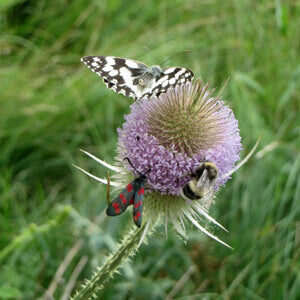Day 5
2.5 m² flowering meadow for butterflies in Thuringia
 Of Golden Eights and Small Purple Emperor Butterflies
Of Golden Eights and Small Purple Emperor Butterflies


Flowering meadows for endangered butterflies

need
Meadows rich in flowers and herbs to protect endangered butterflies and other insects.
activity
The NABU Foundation buys meadows at Windknollen and guarantees the grazing by a local shepherd necessary for the preservation of the meadows.
Measurable performance
Number of square meters of meadow that are permanently purchased and placed under nature protection.
Result
Grazing by the shepherd can continue and the biodiversity at Windknollen is actively protected.
Systemically relevant impact
The protection of the wind turbine is guaranteed in the long term and biodiversity is protected.
background


The good deed
AboutGermany
Berlin
Capital city

82 521 653
Population
46.136
Gross domestic product
per capita per year
5
Human Development Index
(Human Development Index)



